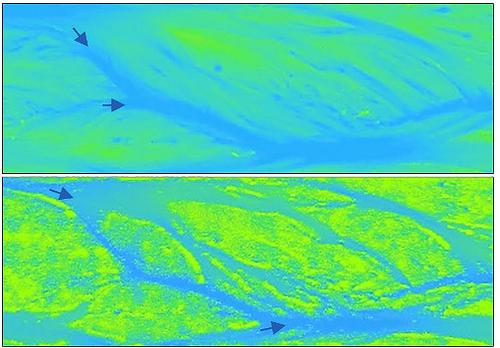当前位置:
X-MOL 学术
›
Earth Surf.Process. Land.
›
论文详情
Our official English website, www.x-mol.net, welcomes your
feedback! (Note: you will need to create a separate account there.)
Riparian vegetation life stages control the impact of flood sequencing on braided river morphodynamics
Earth Surface Processes and Landforms ( IF 2.8 ) Pub Date : 2021-06-22 , DOI: 10.1002/esp.5177 Rocio L. Fernandez 1, 2 , Stuart McLelland 3 , Daniel R. Parsons 3 , Bas Bodewes 1
Earth Surface Processes and Landforms ( IF 2.8 ) Pub Date : 2021-06-22 , DOI: 10.1002/esp.5177 Rocio L. Fernandez 1, 2 , Stuart McLelland 3 , Daniel R. Parsons 3 , Bas Bodewes 1
Affiliation

|
With riverine flooding set to be more frequent in many parts of the world as a result of climate change, the interactions between fluvial morphodynamics and riparian vegetation may depend in part on the sequence of flood events. This paper describes a laboratory study of the geomorphic adjustment of a braided river to sequences of floods across five different strengths of braidplain vegetation. By using alfalfa as a proxy for braidplain vegetation, the differing plant life stages were used to represent the varying strengths of biogeomorphic feedbacks across the floods. Boundary conditions were constrained by sets of experimental runs with both equilibrium sediment loads and deficit loads. Changes in bed topography were monitored and assessed using a detailed digital elevation model, digital imagery and continuous monitoring of the transported sediment. Results demonstrate that in absence of plant colonization, vegetation placed the rivers in a non-equilibrium condition, in which riparian vegetation encouraged the development of new channels, increased the system channel width and enhanced topographic irregularity, these effects being more noticeable during the low-flow periods. The morphodynamics was found to be less sensitive to variations in flood discharges as the vegetation influence (strength) increased from minimum to maximum, until vegetation began to die back and the impacts of flood sequences became yet again evident. Although the overall sediment transport rate was reduced under full-grown vegetation conditions, the presence of the mature plants across the braid bars resulted in the greatest channel scour depths. Results are considered in light of expected changes in flood frequency with climate and likely morphodynamic responses of river systems as a result.
中文翻译:

河岸植被生命阶段控制洪水排序对辫状河形态动力学的影响
由于气候变化,世界许多地区的河流洪水将更加频繁,河流形态动力学与河岸植被之间的相互作用可能部分取决于洪水事件的顺序。本文描述了辫状河对五种不同强度的辫状平原植被的洪水序列的地貌调整的实验室研究。通过使用苜蓿作为辫状平原植被的代表,不同的植物生命阶段被用来代表洪水中生物地貌反馈的不同强度。边界条件受具有平衡沉积物载荷和亏缺载荷的多组实验运行的约束。使用详细的数字高程模型监测和评估河床地形的变化,运输沉积物的数字图像和连续监测。结果表明,在没有植物定植的情况下,植被使河流处于非平衡状态,其中河岸植被促进了新河道的发展,增加了系统河道宽度并增强了地形不规则性,这些影响在低水期更为明显。流动期。随着植被影响(强度)从最小增加到最大,形态动力学对洪水流量的变化不太敏感,直到植被开始枯萎,洪水序列的影响再次变得明显。尽管在完全生长的植被条件下总体泥沙输运速率降低,但编织带上成熟植物的存在导致了最大的河道冲刷深度。
更新日期:2021-06-22
中文翻译:

河岸植被生命阶段控制洪水排序对辫状河形态动力学的影响
由于气候变化,世界许多地区的河流洪水将更加频繁,河流形态动力学与河岸植被之间的相互作用可能部分取决于洪水事件的顺序。本文描述了辫状河对五种不同强度的辫状平原植被的洪水序列的地貌调整的实验室研究。通过使用苜蓿作为辫状平原植被的代表,不同的植物生命阶段被用来代表洪水中生物地貌反馈的不同强度。边界条件受具有平衡沉积物载荷和亏缺载荷的多组实验运行的约束。使用详细的数字高程模型监测和评估河床地形的变化,运输沉积物的数字图像和连续监测。结果表明,在没有植物定植的情况下,植被使河流处于非平衡状态,其中河岸植被促进了新河道的发展,增加了系统河道宽度并增强了地形不规则性,这些影响在低水期更为明显。流动期。随着植被影响(强度)从最小增加到最大,形态动力学对洪水流量的变化不太敏感,直到植被开始枯萎,洪水序列的影响再次变得明显。尽管在完全生长的植被条件下总体泥沙输运速率降低,但编织带上成熟植物的存在导致了最大的河道冲刷深度。










































 京公网安备 11010802027423号
京公网安备 11010802027423号